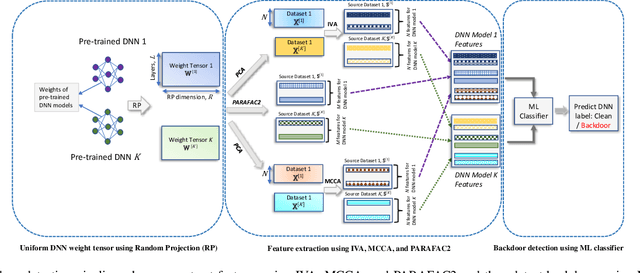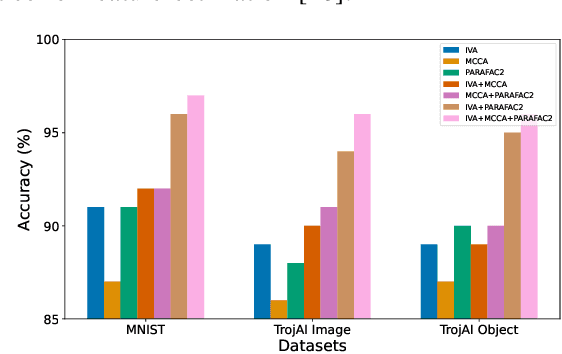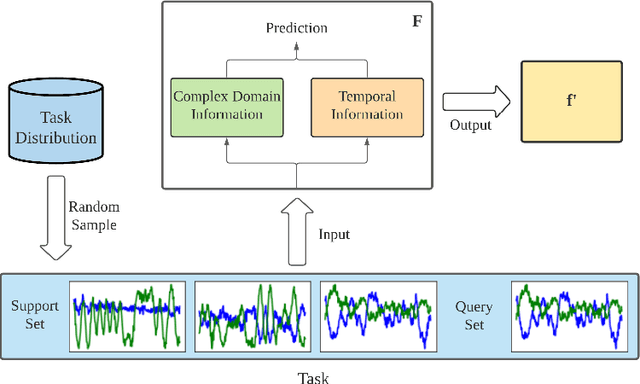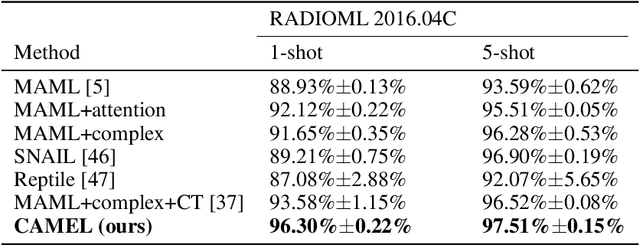Khondoker Murad Hossain
DeBUGCN -- Detecting Backdoors in CNNs Using Graph Convolutional Networks
Feb 25, 2025Abstract:Deep neural networks (DNNs) are becoming commonplace in critical applications, making their susceptibility to backdoor (trojan) attacks a significant problem. In this paper, we introduce a novel backdoor attack detection pipeline, detecting attacked models using graph convolution networks (DeBUGCN). To the best of our knowledge, ours is the first use of GCNs for trojan detection. We use the static weights of a DNN to create a graph structure of its layers. A GCN is then used as a binary classifier on these graphs, yielding a trojan or clean determination for the DNN. To demonstrate the efficacy of our pipeline, we train hundreds of clean and trojaned CNN models on the MNIST handwritten digits and CIFAR-10 image datasets, and show the DNN classification results using DeBUGCN. For a true In-the-Wild use case, our pipeline is evaluated on the TrojAI dataset which consists of various CNN architectures, thus showing the robustness and model-agnostic behaviour of DeBUGCN. Furthermore, on comparing our results on several datasets with state-of-the-art trojan detection algorithms, DeBUGCN is faster and more accurate.
Advancing Security in AI Systems: A Novel Approach to Detecting Backdoors in Deep Neural Networks
Mar 13, 2024



Abstract:In the rapidly evolving landscape of communication and network security, the increasing reliance on deep neural networks (DNNs) and cloud services for data processing presents a significant vulnerability: the potential for backdoors that can be exploited by malicious actors. Our approach leverages advanced tensor decomposition algorithms Independent Vector Analysis (IVA), Multiset Canonical Correlation Analysis (MCCA), and Parallel Factor Analysis (PARAFAC2) to meticulously analyze the weights of pre-trained DNNs and distinguish between backdoored and clean models effectively. The key strengths of our method lie in its domain independence, adaptability to various network architectures, and ability to operate without access to the training data of the scrutinized models. This not only ensures versatility across different application scenarios but also addresses the challenge of identifying backdoors without prior knowledge of the specific triggers employed to alter network behavior. We have applied our detection pipeline to three distinct computer vision datasets, encompassing both image classification and object detection tasks. The results demonstrate a marked improvement in both accuracy and efficiency over existing backdoor detection methods. This advancement enhances the security of deep learning and AI in networked systems, providing essential cybersecurity against evolving threats in emerging technologies.
TEN-GUARD: Tensor Decomposition for Backdoor Attack Detection in Deep Neural Networks
Jan 06, 2024



Abstract:As deep neural networks and the datasets used to train them get larger, the default approach to integrating them into research and commercial projects is to download a pre-trained model and fine tune it. But these models can have uncertain provenance, opening up the possibility that they embed hidden malicious behavior such as trojans or backdoors, where small changes to an input (triggers) can cause the model to produce incorrect outputs (e.g., to misclassify). This paper introduces a novel approach to backdoor detection that uses two tensor decomposition methods applied to network activations. This has a number of advantages relative to existing detection methods, including the ability to analyze multiple models at the same time, working across a wide variety of network architectures, making no assumptions about the nature of triggers used to alter network behavior, and being computationally efficient. We provide a detailed description of the detection pipeline along with results on models trained on the MNIST digit dataset, CIFAR-10 dataset, and two difficult datasets from NIST's TrojAI competition. These results show that our method detects backdoored networks more accurately and efficiently than current state-of-the-art methods.
Backdoor Attack Detection in Computer Vision by Applying Matrix Factorization on the Weights of Deep Networks
Dec 15, 2022Abstract:The increasing importance of both deep neural networks (DNNs) and cloud services for training them means that bad actors have more incentive and opportunity to insert backdoors to alter the behavior of trained models. In this paper, we introduce a novel method for backdoor detection that extracts features from pre-trained DNN's weights using independent vector analysis (IVA) followed by a machine learning classifier. In comparison to other detection techniques, this has a number of benefits, such as not requiring any training data, being applicable across domains, operating with a wide range of network architectures, not assuming the nature of the triggers used to change network behavior, and being highly scalable. We discuss the detection pipeline, and then demonstrate the results on two computer vision datasets regarding image classification and object detection. Our method outperforms the competing algorithms in terms of efficiency and is more accurate, helping to ensure the safe application of deep learning and AI.
 Add to Chrome
Add to Chrome Add to Firefox
Add to Firefox Add to Edge
Add to Edge